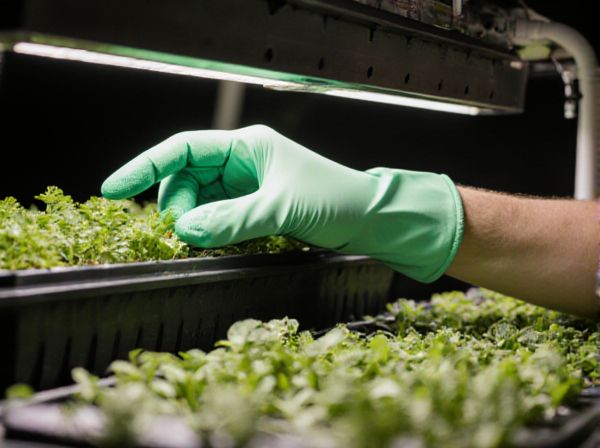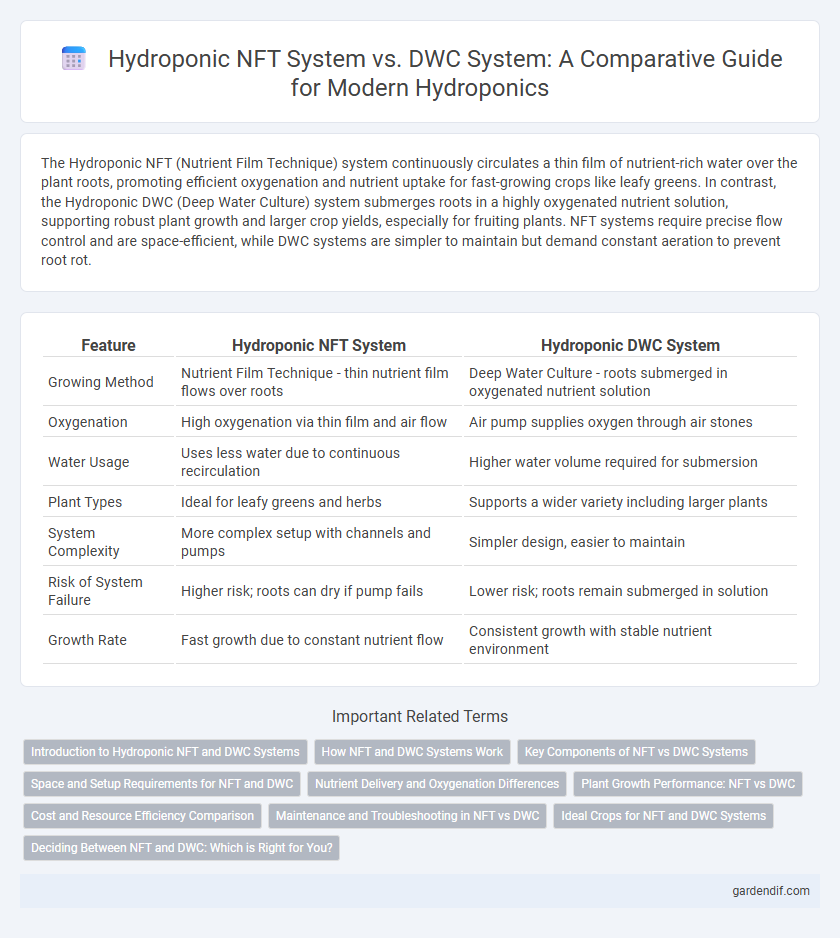
Hydroponic NFT system vs Hydroponic DWC system Illustration
The Hydroponic NFT (Nutrient Film Technique) system continuously circulates a thin film of nutrient-rich water over the plant roots, promoting efficient oxygenation and nutrient uptake for fast-growing crops like leafy greens. In contrast, the Hydroponic DWC (Deep Water Culture) system submerges roots in a highly oxygenated nutrient solution, supporting robust plant growth and larger crop yields, especially for fruiting plants. NFT systems require precise flow control and are space-efficient, while DWC systems are simpler to maintain but demand constant aeration to prevent root rot.
Table of Comparison
| Feature | Hydroponic NFT System | Hydroponic DWC System |
|---|---|---|
| Growing Method | Nutrient Film Technique - thin nutrient film flows over roots | Deep Water Culture - roots submerged in oxygenated nutrient solution |
| Oxygenation | High oxygenation via thin film and air flow | Air pump supplies oxygen through air stones |
| Water Usage | Uses less water due to continuous recirculation | Higher water volume required for submersion |
| Plant Types | Ideal for leafy greens and herbs | Supports a wider variety including larger plants |
| System Complexity | More complex setup with channels and pumps | Simpler design, easier to maintain |
| Risk of System Failure | Higher risk; roots can dry if pump fails | Lower risk; roots remain submerged in solution |
| Growth Rate | Fast growth due to constant nutrient flow | Consistent growth with stable nutrient environment |
Introduction to Hydroponic NFT and DWC Systems
The Hydroponic NFT (Nutrient Film Technique) system circulates a thin film of nutrient-rich water over plant roots, ensuring constant oxygenation and nutrient absorption, ideal for leafy greens and herbs. In contrast, the Hydroponic DWC (Deep Water Culture) system suspends plant roots directly in oxygenated nutrient solutions, promoting rapid growth through continuous access to water and nutrients. Both systems optimize space and resource efficiency but differ in oxygen delivery and root immersion, influencing plant growth dynamics and maintenance requirements.
How NFT and DWC Systems Work
The Hydroponic NFT (Nutrient Film Technique) system circulates a thin film of nutrient-rich water continuously over the roots of plants positioned in a sloped channel, ensuring constant oxygen and nutrient access. The Hydroponic DWC (Deep Water Culture) system suspends plant roots directly in a nutrient-rich, oxygenated water reservoir, allowing roots to absorb nutrients while oxygen is supplied via air stones. Both systems optimize growth by providing controlled nutrient delivery and oxygenation, but NFT relies on flowing nutrient solution while DWC immerses roots in static nutrient solutions with aeration.
Key Components of NFT vs DWC Systems
The Hydroponic Nutrient Film Technique (NFT) system features a shallow stream of nutrient-rich water flowing continuously over the roots in a sloped channel, relying heavily on channels, a reservoir, and a pump for nutrient circulation. In contrast, the Deep Water Culture (DWC) system suspends plant roots directly in oxygenated nutrient-rich water within large containers, emphasizing the importance of air stones, air pumps, and deep reservoirs to maintain oxygen levels. Key components in NFT include angled channels and a recirculating pump, whereas DWC depends on deep reservoirs with aeration systems for maintaining root oxygenation.
Space and Setup Requirements for NFT and DWC
Hydroponic NFT (Nutrient Film Technique) systems require less vertical space due to their slim channels that allow for stacked or tiered installations, optimizing limited areas effectively. In contrast, Hydroponic DWC (Deep Water Culture) systems need more horizontal space because plants grow in larger containers filled with nutrient solution, demanding greater footprint and depth. Setup for NFT involves precise slope and pump management to maintain nutrient flow, while DWC setups focus on maintaining water aeration and stable nutrient levels in individual reservoirs.
Nutrient Delivery and Oxygenation Differences
The Hydroponic NFT (Nutrient Film Technique) system delivers a continuous thin film of nutrient solution over plant roots, ensuring steady nutrient availability and moderate oxygen exposure; this design enhances oxygenation by allowing roots direct contact with air. In contrast, the Hydroponic DWC (Deep Water Culture) system submerges plant roots in an oxygen-rich nutrient solution, relying heavily on aeration devices like air stones to supply dissolved oxygen. Consequently, NFT systems offer superior oxygen diffusion through root exposure to air, while DWC systems depend on mechanical aeration to maintain optimal oxygen levels for nutrient uptake.
Plant Growth Performance: NFT vs DWC
Hydroponic Nutrient Film Technique (NFT) systems provide a continuous thin film of nutrient solution that enhances oxygen availability to roots, promoting faster plant growth and higher yields in leafy greens. Deep Water Culture (DWC) systems immerse roots in oxygen-rich, aerated nutrient solutions, supporting robust growth and larger fruit development in crops like tomatoes and peppers. While NFT excels in rapid growth cycles with efficient nutrient uptake, DWC offers superior support for larger plants due to constant nutrient and oxygen availability.
Cost and Resource Efficiency Comparison
The Hydroponic NFT (Nutrient Film Technique) system uses a thin film of nutrient solution continuously flowing over the roots, which reduces water and nutrient consumption, making it highly resource-efficient and cost-effective for leafy greens. In contrast, the Hydroponic DWC (Deep Water Culture) system suspends plant roots in an oxygenated nutrient-rich water reservoir, resulting in higher water usage and energy costs due to constant aeration. Overall, NFT systems typically offer lower operational costs and better resource optimization, while DWC systems demand more intensive resource input but can support larger plant sizes.
Maintenance and Troubleshooting in NFT vs DWC
Hydroponic NFT (Nutrient Film Technique) systems require frequent maintenance to prevent channel clogging and ensure a continuous thin film of nutrient solution flows properly, demanding regular inspection for root growth and pump functionality. In contrast, Hydroponic DWC (Deep Water Culture) systems have simpler maintenance routines centered around monitoring water oxygenation and nutrient levels, with common troubleshooting involving root rot prevention and aeration system checks. NFT systems are more sensitive to power outages and flow disruptions, while DWC systems allow for more buffer time to address system faults without immediate crop damage.
Ideal Crops for NFT and DWC Systems
Hydroponic NFT (Nutrient Film Technique) systems are ideal for growing lightweight, fast-growing crops such as lettuce, spinach, and herbs due to their shallow root systems and continuous nutrient flow. In contrast, Hydroponic DWC (Deep Water Culture) systems support larger, water-loving plants like tomatoes, peppers, and cucumbers by providing oxygenated nutrient-rich water that promotes robust root development. Selecting the appropriate system based on crop type optimizes growth efficiency, yield quality, and nutrient uptake in controlled environment agriculture.
Deciding Between NFT and DWC: Which is Right for You?
Hydroponic NFT (Nutrient Film Technique) systems circulate a thin film of nutrient solution over plant roots, offering efficient oxygenation and water usage ideal for fast-growing leafy greens and herbs in limited space. Hydroponic DWC (Deep Water Culture) systems submerge plant roots in oxygen-rich, nutrient-filled water, providing stable growth conditions suited for larger, fruiting plants requiring higher oxygen levels and nutrient availability. Choosing between NFT and DWC depends on crop type, space constraints, and your system management preference, with NFT favoring lightweight, high-density crops and DWC better for robust, oxygen-demanding plants.
Hydroponic NFT system vs Hydroponic DWC system Infographic

 gardendif.com
gardendif.com